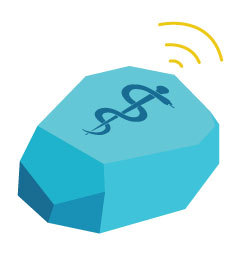Beacons in Healthcare

Thus far, IoT technology has had a minimal impact on the healthcare, consumer goods, and transportation sectors. Healthcare in particular is rife with opportunities to take advantage of IoT. Of the many classes of connected devices, beacons hold the most promise to have an immediate impact on hospitals and care centers in the coming years.
Why Beacons?
There are three reasons why healthcare providers should take a close look at beacons. Firstly, the number of real-world applications for beacons is large. Secondly, the economics of beacon-based solutions is attractive. Finally, and unlike other classes of healthcare technology, many beacon-related solutions are not burdened with the privacy concerns related to presenting, capturing, and storing patient (EMR) data. In other words, there are solutions that can be built today that are outside the scope of difficult to navigate regulations such as HIPAA. The upshot is that administrators who have traditionally been slower to adopt new technology should carefully consider the advantages that beacon-based technology could bring to their facilities.
A Brief Background on beacons
Beacons are cheap, small (quarter-sized to deck of cards-sized) battery-powered devices that emit Bluetooth Low Energy (BLE) packets at regular intervals. Beacons vary in terms of strength and range of the broadcast, broadcast frequency, and battery life. Applications on mobile devices such as tablets or phones can be configured to listen to BLE packets coming nearby beacons. When the BLE packet emitted by the beacon is detected by a device, that is an indication of proximity. Beacons are applicable to a relatively endless series of real-world use cases.
Beacons can be worn by people as wristbands, placed at locations, or fixed to equipment. Where to place the beacon will vary depending on the use case.
Because of their simple nature (all the do is broadcast), beacons do not suffer from some of the interoperability aspects of other IoT devices. In addition the security model for beacons has seen great improvements over the past years. The latest firmware enhancements on beacons prevent spoofing (pretending to be a beacon), which would be the largest concern in a healthcare arena.
Uses of Beacon Technology in Healthcare
Here are just a few uses of beacon technology.
- • patient check-in (for repeat visits and/or after initial admission)
- • locate staff members quickly
- • track time taken between admission to treatment
- • patient protection – guard access to areas of the hospital
- • locate patients/prevent wandering (prevent confused or medicated patients from mistakenly leaving a facility)
- • locate instrumentation and equipment
- • personalization of the hospital experience
- • wayfinding (hospitals are often confusing for visitors)
- • quickly pull up a patient chart/EMR (requires enhanced security mechanism on the mobile side)
- • temporary badge (provide access to patients to visitors to sensitive hospital areas)
As you can see, there is enormous potential for beacons to increase efficiency, improve visitor experience, track patient experience, and save lives. Administrators should seriously consider the benefits this technology can bring to their organizations.
